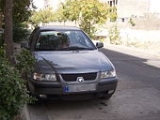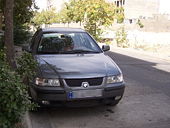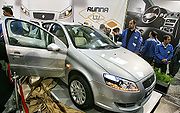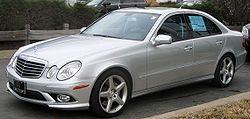
List of Iranian cars
Encyclopedia

Industry of Iran
According to a report by the Economist, Iran has been ranked 39th for producing $23 billion of industrial products in 2008. From 2008 to 2009 Iran has leaped to 28th place from 69th place in annual industrial production growth rate. A recent report by the World Fact Book ranks Iran 3rd among...
, after its oil and gas industry
Petroleum industry in Iran
In 2004 Iran produced 5.1 percent of the world’s total crude oil , which generated revenues of US$25 billion to US$30 billion and was the country’s primary source of foreign currency. At 2006 levels of production, oil proceeds represented about 18.7 percent of gross domestic product . However, the...
, accounting for 10% of Iran's GDP. Today, Iran
Iran
Iran , officially the Islamic Republic of Iran , is a country in Southern and Western Asia. The name "Iran" has been in use natively since the Sassanian era and came into use internationally in 1935, before which the country was known to the Western world as Persia...
is the 12th largest automaker in the world and the largest in the Middle-East, with the total production of 1,395,421 cars, including 35,901 commercial vehicles. In 2009 Iran ranked fifth in car production growth standing next to China, Taiwan, Romania and India.
As of 2001, there were 13 public and privately owned automakers in Iran
Iran
Iran , officially the Islamic Republic of Iran , is a country in Southern and Western Asia. The name "Iran" has been in use natively since the Sassanian era and came into use internationally in 1935, before which the country was known to the Western world as Persia...
, of which two - Iran Khodro
Iran Khodro
Iran Khodro Company, also known as IKCO, is the leading Iranian automaker with headquarters in Tehran. The company's original name was Iran National. IKCO was founded in 1962 and it produced 688,000 passenger cars in 2009...
and Saipa - accounted for 94% of the total domestic production. Iran Khodro, which produced the most prevalent car brand in the country - the Paykan
Paykan
]The Paykan was an automobile produced by the Iranian company Iran Khodro Industrial Group. The car was very popular in Iran from the late 1960s to the late 1990s...
, which has been replaced in 2005 by the Samand -, was still the larger with 61% of the market in 2001, while Saipa contributed 33% of Iran’s total production in the same year.
The Iranian manufacturers currently produce six different types of vehicle, including passenger cars, 4WD, trucks, buses, minibuses, and pickup trucks. The sector directly employs about 500,000 people (roughly 2.3% of the workforce), and many more in related industries. About 75% of local output is passenger cars, with pick-ups the next largest category, accounting for around 15%.
Historical development
In the 60's, lacking the technical know-how and unable to produce its own automobiles, Iran invited western firms in order to start a domestic automobile industry. Since then, Iran has developed its domestic industry where it can design and assemble cars on its own, including a new car factory in KashanKashan
Kashan is a city in and the capital of Kashan County, in the province of Isfahan, Iran. At the 2006 census, its population was 248,789, in 67,464 families....
. The average
operating margin
Operating margin
In business, operating margin — also known as operating income margin, operating profit margin and return on sales — is the ratio of operating income divided by net sales, usually presented in percent....
of the five major Iranian automakers dropped by 1% from 13% to 12% in 2011. The 6 development phases of Iran’s automotive industry have been:
| 1. Assembly with western assistance | 1969–1989 |
| 2. Spare Parts Industry Development | 1990 – Present |
| 3. Auto Design | 1975 – Present |
| 4. Mass Production | 1975 – Present |
| 5. Establishing Export Bases | 2006 – Present |
| 6. Mass Auto Export | 2008 – Present |
Market and domestic production

Tehran Stock Exchange
The Tehran Stock Exchange is Iran's largest stock exchange, which first opened in 1967. The TSE is based in Tehran. As of July 2010, 337 companies with a market capitalization of US$72 billion were listed on TSE...
, the government still owns about 40 percent of both companies. In July 2010, the government sold a further 18% stake in both Iran Khodro and Saipa for about $2 billion in total, bringing down its participation in both companies to about 20%. In August, both deals were cancelled by the Iranian
Privatization Organization. No clear reason was given for the cancellation of the deals, but analysts believe that discontent over the prices at which the blocks were traded is the most likely reason.
The other car manufacturers, such as the Bahman Group
Bahman Group
Bahman Group is a Tehran, Iran-based manufacturer of vehicles under license by Mazda. Founded in 1952 by Mr. Amanollah Sarbaz and his son, they have since then manufactured, under license, versions of Mazda's trucks. Today they manufacture versions of the Mazda B-Series pickups and the previous...
, Rakhsh Khodro, Kerman Motors, Kish Khodro
Kish Khodro
Kish Khodro is a car company based in Kish, Iran. Established in 1998, 40% of the company is owned by the Iranian State Bank. Their original model was the plastic-bodied Sinad I hatchback, which was built by Mohammad Saffari Kermani. This was followed by the differently styled Sinad II and the...
, Raniran, Traktorsazi, Shahab Khodro, and others together produced only 6%. These automakers produce a wide range of automobiles including motorbikes, passenger cars, vans, mini trucks, medium sized trucks, heavy duty trucks, minibuses, large size buses and other heavy automobiles used in commercial and private activities in the country. Iran Khodro Diesel
Iran Khodro Diesel
Iran Khodro Diesel Company is a leading manufacturer of commercial vehicles in the Iranian market and in the market of several other countries in the Middle East, CIS and Africa with half a century experience under license of Daimler Benz...
has a dominant market share (+70%) in bus, truck and van production.
Iran with having a fleet of 7 million passenger cars, buses and trucks ranked the world’s 16th biggest automaker and largest in the Middle East
Middle East
The Middle East is a region that encompasses Western Asia and Northern Africa. It is often used as a synonym for Near East, in opposition to Far East...
in 2006 with annual production above 1 million units and 1.3 million in 2009, resulting in almost 1.5 percent of total world production of vehicles and 1 car per 10 person.
By 2010 Iran's fleet reached 11.5 million cars.
Sixty percent of passenger cars produced in 2008 will use natural gas
Natural gas
Natural gas is a naturally occurring gas mixture consisting primarily of methane, typically with 0–20% higher hydrocarbons . It is found associated with other hydrocarbon fuel, in coal beds, as methane clathrates, and is an important fuel source and a major feedstock for fertilizers.Most natural...
as fuel or will be dual-fuel, and the remaining 40 percent will run on regular gasoline (2008). Some problems faced by the industry are slow deliveries of cars, lack of after sales services and low quality in the production of some cars. Car production in Iran has increased 445% between 1998 and 2008.
More than half of the vehicles in Iran are over 25 years old (2007). The government has sought to upgrade the local fleet and the authorities aim to pull some 200,000 outmoded vehicles off the road each year, underpinning demand. According to estimates the demand stood at 1.5 million vehicles in 2007, which could not be met by the local producers. Auto manufacturing industry's share in gross national product is two percent and Iran's auto production rate in the global markets is 1.7 percent (2008).
Motorcycles
There were more than 8 million motorcycles in Iran by 2010 and 1,500 motorcycles receive registration number plates each day. Motorcycles account for 30% of air pollution in Tehran. Domestically manufactured motorcycles conform to Euro 2 standard and they don't even use catalyst transducers while the world has now considered Euro 5 standard for motorcycles.Exports
In 2007 Irans car exports stood at around $500 million. Iran car exports are projected to reach $1 billion by March 2009. Overall production is expected to rise to 1.13 million units by 2012 ($200 million in exports expected by 2010) and 60,000 units exported by 2013.Auto parts
Sapco and Sazegostar are the respective purchasing arms of Iran KhodroIran Khodro
Iran Khodro Company, also known as IKCO, is the leading Iranian automaker with headquarters in Tehran. The company's original name was Iran National. IKCO was founded in 1962 and it produced 688,000 passenger cars in 2009...
and Saipa (the two largest Iranian auto manufacturers). The Iranian automotive parts industry consists of approximately 1200 companies (15,000 factories), which include those affiliated to vehicle manufacturers as well as independent firms. The industry consists of two primary sectors: Original Equipment Manufacturing (OEM) suppliers, which produce parts for auto makers, and After-Market Parts Manufacturers (AMPM), which produce replacement parts for vehicles. Over 39 countries purchase Iranian auto parts (2008).
R&D
There are different ongoing R&D projects both at the governmental and private sectors. These projects research are mostly aimed at local market of Iran and its particular problems. New lines of locally designed and manufactured diesel, gasoline and dedicated CNG engines are being developed. There are also some research being done on hybrid and electric vehicles for the future Iranian market. In addition to this nanotechnologyNanotechnology
Nanotechnology is the study of manipulating matter on an atomic and molecular scale. Generally, nanotechnology deals with developing materials, devices, or other structures possessing at least one dimension sized from 1 to 100 nanometres...
is being researched for introduction into production lines in order to improve the quality standards and customer satisfaction by offering anti-bacterial seats, anti-scratch paint, hydrophobic glass panes, maintenance-free air filters, anti-stain dashboards, nano-catalytic converters and nano-diamond containing lubricating oils.
Foreign direct investment and imports

Fiat
FIAT, an acronym for Fabbrica Italiana Automobili Torino , is an Italian automobile manufacturer, engine manufacturer, financial, and industrial group based in Turin in the Italian region of Piedmont. Fiat was founded in 1899 by a group of investors including Giovanni Agnelli...
has also announced of plans to begin production of its Siena
Fiat Siena
The Fiat Siena is the four-door sedan version of the Fiat Palio, a supermini car especially designed for developing countries. The car is similar to Fiat Albea...
sedan in Iran in 2008.
Chery Automobile
Chery Automobile
Chery Automobile Co Ltd is a state-owned automobile manufacturer in the People's Republic of China.Chery became the 7th most-productive Chinese vehicle manufacturer in 2010, selling nearly 700,000 units.-History:...
(China) in August 2007 entered into a US$370m joint venture with Iran Khodro
Iran Khodro
Iran Khodro Company, also known as IKCO, is the leading Iranian automaker with headquarters in Tehran. The company's original name was Iran National. IKCO was founded in 1962 and it produced 688,000 passenger cars in 2009...
, Iran to produce cars for the Middle East
Middle East
The Middle East is a region that encompasses Western Asia and Northern Africa. It is often used as a synonym for Near East, in opposition to Far East...
. Chery Automobile is to hold 30% of the venture, and Khodro will hold 49%. Solitac, a Canadian front company, is to hold the remaining 21% of the venture. The factory will be in the Iranian city of Babol
Babol
Babol is a city in and the capital of Babol County, Mazandaran Province, Iran. At the 2006 census, its population was 198,636, in 55,943 families....
. Anhui Ankai Automobile
Anhui Ankai Automobile
Anhui Ankai Automobile Co., Ltd is a Chinese company engaged in the manufacturing of passenger vehicles and relevant chassis. Anhui Ankai Automobile provides its products under the brand named ANKAI, including sleeping berth passenger vehicles, regular passenger vehicles, urban buses, automobile...
(also of China) signed a deal in January 2008 with ARG-Diesel Iran to supply it with 600 buses, valued at €51.35m. The deal is to be complete by October 2008.
Iran annually needs some 4,000 buses for its domestic transportation. Since the 1970s, Iran has been producing a number of different buses, such as German Mercedes and MAN as well as Swedish Scania and Volvo that it has exported throughout the Middle East. Daewoo Bus
Daewoo Bus
Daewoo Bus Corporation is a manufacturer of buses. headquartered in Busan, South Korea, established in 2002. These buses are primarily used for public transportation. Daewoo Bus is South Korea's second-largest bus manufacturer, and has been in parnership with GM Daewoo since 2006...
Corp. and an Iranian automaker Ardebil Sabalan Khodrow-Maywan have teamed up to build buses in Iran. The plant, which is slated to be completed by March 2010, would have a production capacity of 2,000 buses per year and would produce some 800 city and intercity buses in the 18 months after its inauguration. Based on the agreement, the engines and gearboxes would be manufactured in South Korea. But production would increasingly shift to Iran, where about 60 percent of the parts would be made.
Imports
Car imports have risen, from $184 million in 2002 to $1.5 billion in 2007.In 2006, the government lowered the automotive import tariff levels to 90 percent for light weight vehicles and since then a huge influx of imported vehicles has been witnessed in the country. The tariff level for import of heavy vehicles is even lower at 20 percent, due to low levels of local production and high demand. As a result, a variety of automotive brands are being presently imported into Iran including Toyota, BMW, Mercedes Benz (these three being the expensive and/or luxury brands), Rover, Ssangyong, Audi, Subaru, Volkswagen, Renault Leon, Altea variety of heavy vehicles, construction and mining equipment from leading manufacturers such as Mercedes Benz, Renault, Iveco, Mann, Kamaz, Caterpillar.
Fuel rationing
Demand is supported by the fixing of fuel prices2007 Gas Rationing Plan in Iran
2007 Gasoline Rationing Plan in Iran was launched by president Mahmoud Ahmadinejad's cabinet to reduce that country's fuel consumption. Although Iran is one of the world's largest producers of petroleum, rapid increases in demand and limited refining capacity has forced the country to import about...
well below market levels. Regular petrol in Iran costs IR800/litre (9 US cents/litre) and premium grade petrol IR1,100. The nation's abundant oil reserves have enabled the government to keep prices low (Iran is the second-largest exporter in OPEC). However, low prices have encouraged wasteful consumption and the smuggling of petrol into neighbouring countries such as Turkey
Turkey
Turkey , known officially as the Republic of Turkey , is a Eurasian country located in Western Asia and in East Thrace in Southeastern Europe...
, Pakistan
Pakistan
Pakistan , officially the Islamic Republic of Pakistan is a sovereign state in South Asia. It has a coastline along the Arabian Sea and the Gulf of Oman in the south and is bordered by Afghanistan and Iran in the west, India in the east and China in the far northeast. In the north, Tajikistan...
and Afghanistan
Afghanistan
Afghanistan , officially the Islamic Republic of Afghanistan, is a landlocked country located in the centre of Asia, forming South Asia, Central Asia and the Middle East. With a population of about 29 million, it has an area of , making it the 42nd most populous and 41st largest nation in the world...
. Some 1.8 billion liters of oil products worth 10 trillion rials ($1 billion) are smuggled out of Iran
Iran
Iran , officially the Islamic Republic of Iran , is a country in Southern and Western Asia. The name "Iran" has been in use natively since the Sassanian era and came into use internationally in 1935, before which the country was known to the Western world as Persia...
per annum.
Given Iran's limited refining capacity, there has been a shortfall in petroleum products in recent years, requiring Iran to import an estimated 100000 oilbbl/d in 2006/07. As a result, there is a recognition among many policymakers of the need to raise prices, and gradual increases have been implemented. However, these have tended to lag the prevailing rate of inflation, and given that raising petrol prices is politically difficult the provision of cheap fuel is likely to persist in the medium term, encouraging the purchase of vehicles. The government was nevertheless forced to take action in June 2007 when it announced both a petrol increase to 12 cents/litre and the imposition of fuel rationing
2007 Gas Rationing Plan in Iran
2007 Gasoline Rationing Plan in Iran was launched by president Mahmoud Ahmadinejad's cabinet to reduce that country's fuel consumption. Although Iran is one of the world's largest producers of petroleum, rapid increases in demand and limited refining capacity has forced the country to import about...
, much to the chagrin of vehicle owners. The policy, which allocates 120 litres maximum per month (following revisions in December) to private car owners, will run until end-2008/09.
In 2008 and 2009, Iranian government spent over 3 billion dollars on CNG infrastructure as part of its plan to convert its fuel policy from gasoline to CNG.
Perspective
| Iran Automotive Forecast (Source: EIU) | 2007 | 2008 | 2009 | 2010 | 2011 | 2012 |
|---|---|---|---|---|---|---|
| New passenger car registrations ('000) | 1,294 | 1,447 | 1,563 | 1,669 | 1,806 | 1,962 |
| Stock of passenger cars (per 1,000 population) | 94 | 107 | 119 | 133 | 146 | 159 |
Like other sectors, the automotive industry is suffering from a lack of foreign direct investment
Foreign Direct Investment in Iran
Foreign direct investment in Iran has been hindered by unfavorable or complex operating requirements and by international sanctions, although in the early 2000s the Iranian government liberalized investment regulations. Iran ranks 62nd in the World Economic Forum's 2011 analysis of the global...
(FDI) and capital imports. The privatization
Privatization in Iran
According to the Fourth Five-Year Economic Development Plan , the Privatization Organization of Iran affiliated to the Ministry of Economic Affairs and Finance is in charge of setting prices and ceding shares to the general public and on the Tehran Stock Exchange...
process is moving extremely slowly (2008). International sanctions
Sanctions against Iran
This article outlines economic, trade, scientific and military sanctions against Iran, which have been imposed by the U.S. government, or under U.S. pressure by the international community through the United Nations Security Council...
, high inflation, exacerbated by fuel price hikes
2007 Gas Rationing Plan in Iran
2007 Gasoline Rationing Plan in Iran was launched by president Mahmoud Ahmadinejad's cabinet to reduce that country's fuel consumption. Although Iran is one of the world's largest producers of petroleum, rapid increases in demand and limited refining capacity has forced the country to import about...
, and dampened consumer demand have depressed growth in the passenger car segment, but industrial growth coupled with infrastructural development is spurring demand in the commercial vehicles segment. Iranian automotive market will contract in the 2008/09 Iranian year (running from 20 March) and that annual domestic sales are unlikely to exceed 1mn units over the next five years. Experts believe that the removal of subsidies is likely to have an adverse impact on the profitability of the automotive sector for at least the next 2-3 years (until 2013).
See also
- International Rankings of Iran in Transportation
- Economy of IranEconomy of IranThe economy of Iran is the eighteenth largest in the world by purchasing power parity and according to Iranian officials' claims is going to become the 12th largest by 2015. The economy of Iran is a mixed and transition economy with a large public sector and some 50% of the economy centrally planned...
- Transport in IranTransport in IranTransport in Iran is inexpensive because of the government's subsidization of the price of gasoline. The downside is economic inefficiency because of highly wasteful consumption patterns, contraband with neighboring countries and air pollution...
- Industry of IranIndustry of IranAccording to a report by the Economist, Iran has been ranked 39th for producing $23 billion of industrial products in 2008. From 2008 to 2009 Iran has leaped to 28th place from 69th place in annual industrial production growth rate. A recent report by the World Fact Book ranks Iran 3rd among...
External links
- Iranian automobile industry - Brief study (2008) - Market share and production level by manufacturers, type of vehicle (cars, 4WDs, buses or trucks)
- Iranian automobile industry - Brief study (2003)
- Iran Auto, 69-page report, 2008
- B.M.I: Iran Autos Report Q4 2011
- Cars produced in Iran (pictures)
Videos
- Iran car industry (PressTV 2011)

